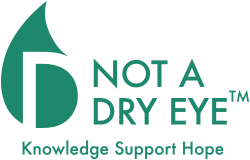One of the reasons we started the Not A Dry Eye Foundation was the frustration we felt when confronted by physicians who dismissed our symptoms as being “something we would learn to live with” or “all in our heads.” Not only were we mystified by their (lack of) diagnosis and conclusions, but we were terrified at the prospect of having to live with unbearable eye pain for the rest of our lives, and this without anyone telling us the causes of Dry Eye pain. 
When we eventually learned about the ways the disease can quickly escalate and the way it can alter the tissue, secretions, and functioning of various eye structures, we felt vindicated. We knew all along that nothing that we were experiencing was psychological, neurological, or psychosomatic in nature. It was physical – blocked meibomian glands, inadequate aqueous tears, wrinkled conjunctiva, bacteria, twisted lashes, demodex mites, allergies, and more.
Learn about the causes of Dry Eye pain
And there was a lot that could be done about each of these conditions so we wouldn’t have to learn how to live in extreme, debilitating, and unbearable pain for the rest of our lives. There was probing for obstructed meibomian glands, punctal cautery for aqueous deficiency, surgery for the wrinkled conjunctiva, antibiotics for infections, epilation for misdirected lashes, and any number of medications or other treatments for anything and everything else.
But with all of these possible diseases taking hold in the eyes at the same time, is it no wonder that we felt pain? If a single eye lash can stop us cold, why wouldn’t a host of diseases cause unbearable pain in the most sensitive part of the body?
Dubious Causes of Dry Eye Pain
And so we became frustrated once again when we learned that physicians at a prominent teaching hospital and a VA hospital concluded that “neuropathic ocular pain due to Dry Eye is associated with multiple comorbid chronic pain syndromes.”
To us, this is like saying that when you have a diseased finger and are experiencing pain in that finger, the pain is due to some other chronic pain syndrome, not to the disease in your finger.
What?
We wonder if the authors will next conclude that the treatment should be Lyrica or some other anesthetizing pain medication? Or maybe serum tears? Or scleral lenses?
Maybe.
But we think there’s a much better approach.
It has to do first with correct and comprehensive diagnosis, the most important step in alleviating symptoms, and then targeted therapy for each co-morbidity — the approach taken by our doctor, Dr. Steven Maskin.
And so we conclude by citing a different study by some of the same physicians at the same teaching and VA hospitals who concluded that ocular pain associated with Dry Eye may be due to conjunctivochalasis, and that patients should be screened for the disease.
Now we’re getting somewhere. That’s the spirit. Happy New Year!
References
Neuropathic ocular pain due to dry eye is associated with multiple comorbid chronic pain syndromes
Galor A, Covington D, Levitt AE, McManus KT, Seiden B, Felix ER, Kalangara J, Feuer W, Patin DJ, Martin ER, Sarantopoulos KD, Levitt RC.
The journal of pain : official journal of the American Pain Society
2015 Nov 19. pii: S1526-5900(15)00944-X. doi: 10.1016/j.jpain.2015.10.019. [Epub ahead of print]
View the full report
The impact of conjunctivochalasis on dry eye symptoms and signs
Chhadva P, Alexander A, McClellan AL, McManus KT, Seiden B, Galor A.
Investigative Ophthalmology and Visual Science
2015 May 1;56(5):2867-71. doi: 10.1167/iovs.14-16337.
View the full report
Subscribe to our blog to keep up with Not A Dry Eye.
Support Not A Dry Eye Foundation by shopping on Amazon. When you shop at smile.amazon.com, Amazon donates 0.5% of your purchase.

